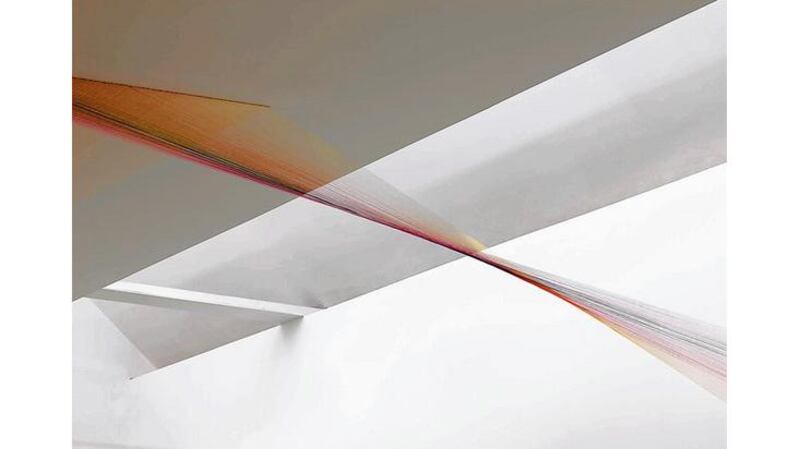ANOTHER PLACEis Mark Garry's first solo show at the Kerlin Gallery, although he has exhibited often and widely, and his presence has been otherwise evident across a range of cultural activities. He sees the variety of his endeavours as forming part of one overall practice, rather than being a series of potential alternatives. That might seem odd in an era of inexorably increasing specialisation, but we'd be in every way much the poorer without polymaths and, for an artist of, say, Leonardo da Vinci's time, there was nothing exceptional about multi-tasking. (We don't necessarily think of Leonardo as a designer of lavish parties but that, professionally, was a large part of what he did.)
Born in Mullingar in 1972 and based in Dublin for some time now, Garry has curated many exhibitions and projects, he's been involved in music recording, in graphic design and in film-making (he appears to be a good screen actor) and, who knows, might even be described as a party designer a làDa Vinci. It's fair to say that he's not a freelance curator in the normal sense of the term, in that the group projects he's devised are very much in keeping with his own approach and sensibility.
That sensibility has to do with contemporary alternative culture, involving a wariness of material excess, consumerism and corporate values, an emphasis on intimate, individual expression and a tacit acknowledgement that there is something fragile and vulnerable, something wounded, in the current state of the world. At the same time all this doesn’t imply a rejection of modernity or the adoption of a starry-eyed idealism. Garry likes and employs manual craft skills, but the evidence suggests that he is technologically literate and practical. His work could be directly related to that of Isabel Nolan, Kathy Prendergast or Tadgh McSweeney to take but three, not because of any direct physical resemblance, but because aspects of their thinking and feeling overlap.

When Garry exhibits his own work it’s usually site-specific. The Kerlin show features a good example of what has become his signature piece, a rainbow fashioned from rows of coloured thread, simply anchored by pins, soaring and swooping through the exhibition space.
It’s fairly low-tech, but meticulous, and when you see it it’s hard not to think of the quiet, methodical effort involved in putting it together – putting it together, as well, in the knowledge that it’s a temporary, ephemeral installation that will soon be dis-assembled. We encounter the work, and not its making, but the making does seem to be an important part of it.
Garry has referred to his interest in the way we experience spaces. The rainbow installations draw our attention to the spaces they occupy in the way they change, sometimes disappearing completely then reappearing in shimmering waves of colour, as we move through the space. As a gallery, the Kerlin is a white cube, a clean, bright, airy container for art, and one could imagine a more striking setting for one of Garry’s rainbows – in fact they are especially good in spaces with limited light sources and a lot of historical texture – but actually it’s really effective. And given the symbolism of rainbows, it’s optimistic.
The show features diverse bodies of work, all different from each other, though with a common interest in rhythmic patterns and processes, and all persuasive. Apart from the rainbow, though, the other highlight is probably a set of sculptures, carvings of blue-eyed grasses in basswood, a soft, versatile North American wood. They’re beautiful and understated, being a natural wood colour. With them, Garry may well be alluding to a rainbow-like evanescent quality. Blue-eyed grass is not a grass but a flower with foliage that resembles a grass, and it flourishes in grasslands, its blooms opening fleetingly and disappearing back into anonymity among the stems. Garry’s carvings feature the open flowers, but they are wood-coloured.
It’s a show that merits a considered visit.
SO TOO DOES Róisín Lewis's R497at the Ashford Gallery. Her botanically exact drawings and watercolours are exquisitely well made. They recall needlework and textile skills and a group of watercolours of sycamore leaves was inspired by antique lacework and textile prints. Lewis works with installation as well and the wider framework of her project is relevant to the works on paper that we see at the Ashford.
R497is part of a larger project, Lesser Trefoils, derived from botanist Nathaniel Cogan's 1893 bid to pin down just what people meant when they described particular plants as shamrock. He invited people to send him shamrocks. What they meant by shamrock, he learned, was any one of a number of plants, including, Lewis reports, "white clover, Red Clover, Black Medick and Wood Sorrel". She has been engaged on her own version of Cogan's undertaking. As she travels throughout Ireland she gathers trifoliate seedlings and, back home, plants and nurtures them, observing them as they grow.
Her drawings and watercolours chronicle their exact form over the span of their life cycle. The title of her show refers to the R497(between Nenagh and Tipperary town), the road from which she gathered the seeds to grow the plants depicted in the exhibition. The consistency and precision of her works are exceptional, our awareness of the plants' vulnerability heightened by the way they are displayed unframed and unglazed. The RHA offers essential viewing at the moment, with a knock-out show by Nevan Lahart in the main upstairs space – but don't miss out on Lewis's in the Ashford while you're there.
Another Place, Kerlin Gallery, Sth Anne St, Dublin Until Feb 13
R497, Ashford Gallery, Royal Hibernian Academy, Ely Place, Dublin Until Feb 27









